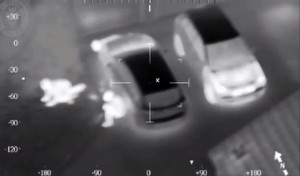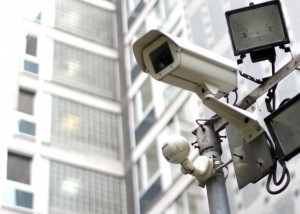 There are many architectural components to a business facility sometimes that includes a parking lot or garage. Whether it is attached or detached, near or far from the main building it can be a convenient asset to any business. It’s likely the place where you and your employees park in the morning and leave in the evening. At some point in your life, whether you were at work or another establishment, you’ve probably had an uneasy feeling walking to your car. But why? Perhaps it had something to do with a perceived lack of security.
There are many architectural components to a business facility sometimes that includes a parking lot or garage. Whether it is attached or detached, near or far from the main building it can be a convenient asset to any business. It’s likely the place where you and your employees park in the morning and leave in the evening. At some point in your life, whether you were at work or another establishment, you’ve probably had an uneasy feeling walking to your car. But why? Perhaps it had something to do with a perceived lack of security.
A parking lot or garage can often go overlooked when it comes to the security of an organization as it is not necessarily looked at as an actual part of the main building. Often times organizations focus on protecting the areas people spend most of their time in, their office or interior work destination. Sometimes a parking lot or garage isn’t even owned by the business it serves but rather an outside property manager. However, parking destinations can often be high risk areas especially at night. As a licensed security systems company our experts at Perfect Connections, Inc. assess the security risks of an organization as a whole. We have been offering comprehensive security solutions to businesses throughout northern and central New Jersey for the past 23 years. We understand not every business or location is the same, and with different locations comes different security risks. Our team helps minimize risk by offering tailored security system solutions.
The risks associated with an unprotected parking lot or garage can be mitigated once brought to light. Speaking of light, it is one of the most important safety factors in parking lots and garages. As you’ve probably experienced at one point or another not all parking areas have adequate lighting, thus creating dark corners and easy hiding spots for potential criminals. According to James Marcella, Director of Technical Services for Axis Communications, “The most effective deterrent to criminal activity is a well-lit area, because not only does it increase the ability for natural surveillance, it also improves the quality of recorded images from security cameras.”
Not only is it imperative for patrons to be able to see, but if something were to happen it’s crucial that security cameras record useable footage. Lighting and surveillance tend to go hand-in-hand. This means installing light fixtures that will provide ample illumination and an adequate CRI (Color Rendition Index) rating. CRI ratings quantify the precision a light source has when it comes to reproducing color. One of the best and overall cost effective options is LED (Light Emitting Diode) lighting.
While lighting is paramount, surveillance is key when it comes to catching criminal behavior, especially in parking lots and garages. In our current technological environment surveillance cameras and equipment are becoming more efficient and advanced. For instance, garage and parking lot environments are not exactly the cleanest or protected areas, therefore surveillance equipment has to be able to withstand harsher elements.
Fortunately there are cameras built specifically for such vulnerable settings. Vandal-resistant cameras happen to be a surveillance solution in volatile areas, providing protection from both human and environmental elements. They typically come sealed from dust and moisture right out of the box making them durable and increasing their longevity. This helps cut down on long term costs of repairs or replacements.
Aside from being durable, ease of integration is becoming a pervasive quality in cameras and security equipment. Today, end-users are starting to migrate from analog camera systems to IP (Internet Protocol) for their image quality, coverage, and scalability. This opens the door to whole system integration where a garage surveillance system can be on the same network as the business it services, or at least that’s the idea. With IP and cloud-based surveillance systems becoming more ubiquitous, clearer images and video analytics are sure to play an important role in the security of any infrastructure, including parking lots and garages. It would help cut down on the need for physical monitoring services as well provide a platform for remote access via a mobile device or computer.
When enhancing the safety of your parking lot or garage it’s important to consider landscaping, signage, cashier booths and pay stations, and alert systems for the patrons. Landscaping around a garage or lot should be well kept and vegetation should be trimmed low to maintain a clear line of sight. There should be clear signage that improves way-finding and some that indicates the area is under surveillance. Sometimes seeing signage is enough to deter criminal activity. Cashier booths and pay stations are crime targets for obvious reasons, therefore they should be well-lit and have adequate surveillance coverage. Alert systems can be a helpful added security feature that would notify patrons by text message of any issues or disturbances while they are away.
Whether you are the owner of a parking lot/garage or a patron it is critical to ensure its security. It’s not just about being vigilant of your property, it’s about protecting you, your employees, and your patrons. As every location has different risks you should always call on a licensed security systems professional to perform an in-person security assessment. Our team at Perfect Connections, Inc. has been providing comprehensive security solutions to businesses throughout northern and central New Jersey since 1992. Our team is skilled at providing custom solutions tailored specifically to your needs. We appreciate the complexities involved in protecting an organization as a whole.
If you live or run a business in Central or Northern New Jersey and would like information on any of the topics discussed above, please call 800-369-3962 or simply CLICK HERE.
Image Credit: Image by David Hilowitz-Flickr-Creative Commons
 We’ve all seen those puffy white, wondrous, water vapor creations up in the sky, commonly known as clouds. These natural wonders are not the clouds we’ll be investigating here. Instead we’ll be taking a look at what the “cloud” is in relation to business networks and their security infrastructure.
We’ve all seen those puffy white, wondrous, water vapor creations up in the sky, commonly known as clouds. These natural wonders are not the clouds we’ll be investigating here. Instead we’ll be taking a look at what the “cloud” is in relation to business networks and their security infrastructure. Not all surveillance cameras are created equally. It may seem as simple as selecting a surveillance camera and popping it into place, but what about the external factors that affect the quality of recorded images? One of the top concerns for industry professionals and end-users alike is a cameras ability to function in the dark or varied light conditions. Whether you’re using interior or external cameras, their ability to function under varied light conditions is paramount. Our experts at
Not all surveillance cameras are created equally. It may seem as simple as selecting a surveillance camera and popping it into place, but what about the external factors that affect the quality of recorded images? One of the top concerns for industry professionals and end-users alike is a cameras ability to function in the dark or varied light conditions. Whether you’re using interior or external cameras, their ability to function under varied light conditions is paramount. Our experts at  To understand the relationship between megapixels and video surveillance let’s first figure out what megapixel means. A
To understand the relationship between megapixels and video surveillance let’s first figure out what megapixel means. A  stem can be one of the best ways to protect your business from unpredictable threats like fires and burglars. Did you know that not all systems are the same? That’s right there really isn’t a “one size fits all” solution when it comes to securing your workplace, nor should there be. Why? Because no two businesses are exactly the same. Therefore, doesn’t it make sense that a security system should be tailored to a facility’s individual needs? A healthcare facility wouldn’t have all the same security needs as a retail store, right? Right. So how do you go about finding the right system for your business? Your best option is to hire a licensed professional in the security system field who has extensive knowledge and experience. At
stem can be one of the best ways to protect your business from unpredictable threats like fires and burglars. Did you know that not all systems are the same? That’s right there really isn’t a “one size fits all” solution when it comes to securing your workplace, nor should there be. Why? Because no two businesses are exactly the same. Therefore, doesn’t it make sense that a security system should be tailored to a facility’s individual needs? A healthcare facility wouldn’t have all the same security needs as a retail store, right? Right. So how do you go about finding the right system for your business? Your best option is to hire a licensed professional in the security system field who has extensive knowledge and experience. At  As a business owner you want to do everything in your power to protect what you’ve worked so hard for, right? So how do you do that? Some might hire security personnel to stand guard and keep an eye on their facility, which can get expensive. Others may opt for reinforced locks on their entrances. But the best solution to truly protecting your business is a comprehensive security system that includes a surveillance system. Surveillance is a key component in defending your facility. If you have a security system that has a burglar alarm but no camera system, what happens when someone breaks-in, gets away, and there’s no footage of the incident to help catch the perpetrator? A surveillance system can help prevent not only burglary, but employee theft, workplace violence, and vandalism.
As a business owner you want to do everything in your power to protect what you’ve worked so hard for, right? So how do you do that? Some might hire security personnel to stand guard and keep an eye on their facility, which can get expensive. Others may opt for reinforced locks on their entrances. But the best solution to truly protecting your business is a comprehensive security system that includes a surveillance system. Surveillance is a key component in defending your facility. If you have a security system that has a burglar alarm but no camera system, what happens when someone breaks-in, gets away, and there’s no footage of the incident to help catch the perpetrator? A surveillance system can help prevent not only burglary, but employee theft, workplace violence, and vandalism.


